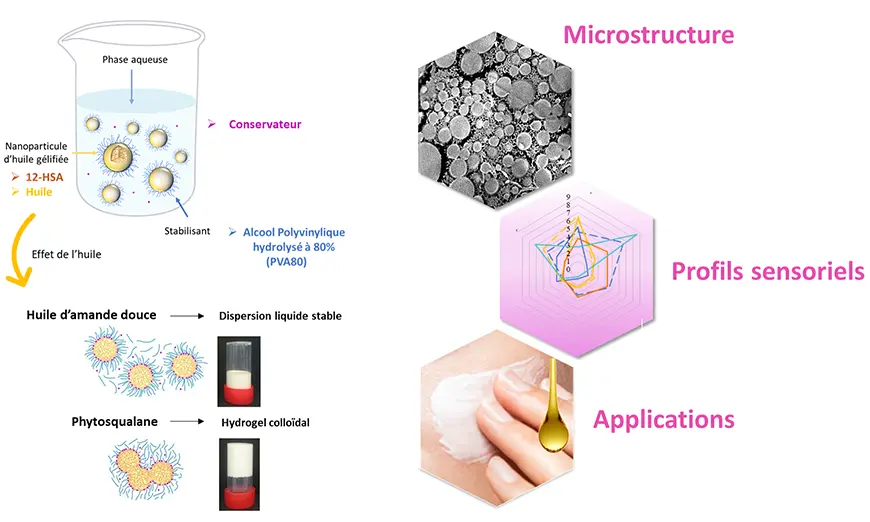Bérénice carried out her research in the SMODD team at the Softmat laboratory in close collaboration with the URCOM laboratory in Le Havre.
This thesis aimed to develop eco-responsible cosmetic formulas with a low number of ingredients, in line with the current context of “Clean-label” in this sector. Bérénice focused on dispersions of gelled oil particles, called “gelosome dispersions”, which have not yet been explored for cosmetic use. Known to be stable and capable of encapsulating hydrophobic active ingredients, the question of their texture and their application onto the surface of the skin remains unanswered to date.

They are prepared by hot emulsification of an organogel, composed of oil and a lipophilic gelator (12-hydroxystearic acid), in the presence of a stabilising agent (80% hydrolysed polyvinyl alcohol). Upon cooling, the emulsion leads to a dispersion of organogel particles.
She first demonstrated the possibility of making gelosome dispersions with cosmetic oils and a preservative. A wide variety of textures was obtained, ranging from fluid liquids to firm and brittle gels. Physicochemical analysis and microscopic observation of these new formulas made it possible to identify their microstructures: under certain conditions, connections are formed between the gelosomes, and a colloidal hydrogel is obtained. The factors and mechanisms leading to individualised or connected gelosomes were determined by the study of interactions at the interface. Gelosome dispersions, even the most fluid, showed great stability.
Finally, new dispersions of gelosomes were formulated using stabilisers of various types and stabilisation modes. The methodology used during this work enabled the establishment of a link between the stabiliser and the properties of the dispersions. Different mechanisms could be identified, inducing interesting and varied microstructures and application properties. For the first time, the texture properties of the dispersions, characteristic of a topical application, were collected across all systems using a combined approach of in vitro rheological analyses and in vivo sensory analyses; the perceptions were described and explained according to the influence of the nature of the oil, the stabiliser and the type of microstructure.
Highlights of the thesis:
- Bérénice was awarded the prize for the best oral communication at the Formula XI international congress in Lille in July 2023;
- an article on her work was published in the journal Colloids and Surfaces A: Physicochemical and Engineering Aspects.
Congratulations to Bérénice for the quality of her work!
